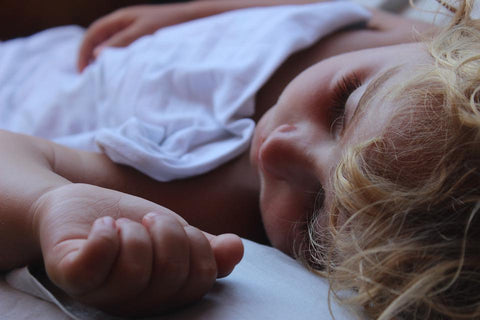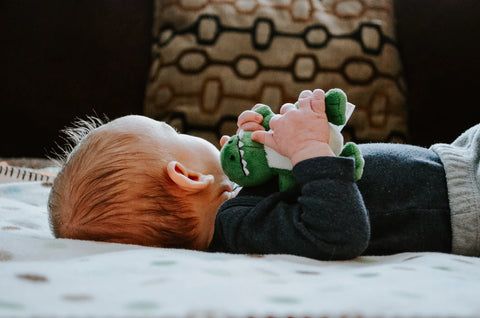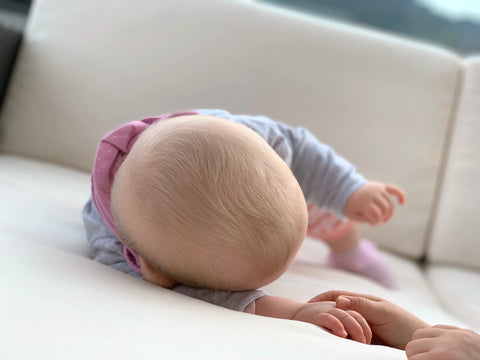Six Common Types of Hair Loss in Infants
•Posted on August 30 2022

Hair loss doesn't just happen to adults, some children also experience hair loss, even little babies. This worries many parents. This is a normal situation and almost all parents have experienced hair loss in their babies.
Parents often bring their babies to see hair loss in the hospital and look at their baby's gradually thinning hair looking very worried. And there will be these questions: Is your baby's hair loss due to calcium deficiency? Vitamin and trace element deficiency? Or do they have ringworm? Of course, the most concerned is whether the baby's hair can still grow out?
This article is about infant hair loss, both physiological and pathological. After reading this article, we will know what we should do when our baby has hair loss.
Table of content:
- Baby hair loss is a normal phenomenon
- Six common types of hair loss in infants
- What to do for infant hair loss?
- Daily hair care for babies
Baby hair loss is a normal phenomenon
Hair loss is a relatively common physiological phenomenon in the growth process of babies, almost every baby from about 2 months after birth will appear in the back of the head, the upper part of the neck hair thinning phenomenon. Parents do not need to be overly nervous.
This is because the roots of newborn hair is not yet firmly attached to the skin, baby sleep due to the weight of the head pressure rubbing scalp, can make the baby's occipital area produce a large area of hair loss, although this friction is not frequent, can also cause the loose hair loss.
Most baby hair loss is a normal physiological phenomenon, generally to about 2 years old, the baby's hair will return to its normal thick state. There are a few baby hair loss because of pathological, when the baby hair loss is more serious, about two years old has not returned to normal state, should take the baby to the hospital for examination, first clear the cause, and then the right treatment.

Six common types of hair loss in infants
Infant hair loss can be divided into two categories: physiological hair loss and pathological hair loss, with physiological hair loss usually being the most common.
Physiological hair loss
Newborn babies are brought out of the mother's womb and most newborns experience significant hair loss around 3 to 5 months after birth.
This is due to the fact that after birth, most of the hair follicles outside of the mother's body rapidly change from the growth phase to the resting phase, and generally when the infant reaches 8-10 months of age, the infant's hair follicles will re-form the hair bulb and grow new hair. This is why it is also called "infantile resting hair loss".
This type of hair loss is characterized by the fact that the baby's hair is black at birth, but slowly turns yellow, and by four or five months after birth, diffuse hair loss occurs.
This type of hair loss is generally physiological and requires no treatment, and most can improve naturally. The exact timing and manner of this hair loss and growth in infants depends on the influence of many factors, including gender, race, genetics, birth conditions (premature, normal, cesarean, etc.), and the nutritional status of the infant, among others.
Pathological hair loss
1.Nutritional deficiencies cause hair loss
When the child is nutritionally deficient, such as wasting, severe malnutrition, zinc deficiency, iron deficiency and other nutritional disorders in infants and children can cause hair loss. Calcium deficiency can cause occipital baldness and is accompanied by a drop in blood calcium, increased alkaline phosphatase, night terrors and irritability, etc. This should be checked at the hospital and various nutrients should be supplemented in time.
2.Nervousness and anxiety cause hair loss
Feeling a lot of stress about life is not exclusive to adults. Babies over 3 months old may also suffer from hair loss due to high psychological stress and prolonged mental tension. This is manifested by a lot of hair falling out when combing or washing the hair, and an overall appearance of less and less hair, but no partial baldness.

3. Various skin diseases cause hair loss
Tinea capitis and other skin diseases can cause hair loss in children. Tinea capitis manifests itself as a fungal infection of the hair and superficial parts of the scalp, and pustular ringworm can be seen locally on the scalp, with red patches of skin and hair loss. Tinea capitis is one of the main factors that cause hair loss in children and requires antibacterial treatment at a regular hospital.
4. Other immune and metabolic diseases cause hair loss
Some immune and metabolic problems can also cause hair loss. Thyroid disease is closely related to baldness, and lupus erythematosus can cause erythema and skin breakdown on the scalp, resulting in hair loss.
5.Congenital hair loss disorders
Some children can suffer from some congenital hair loss disorders. This type of alopecia is an autosomal recessive disorder and is often characterized by severe baldness. If your baby has such symptoms, you need to go to the hospital for further examination.
What to do for infant hair loss?
It is important to first find out what type of hair loss it is and then treat it separately. Generally speaking, physiological hair loss in children does not require treatment. And if the baby has pathological hair loss, parents should take the child to the hospital for further examination as soon as possible and carry out scientific and systematic treatment under the advice of the doctor to ensure the healthy growth of the baby's hair.
Daily hair care for babies
1. Wash your baby's hair regularly
To wash your baby's hair regularly, keep your baby's head dry and clean. Babies because of the growth and development rate is very fast, metabolism is also particularly vigorous, so the oil on the scalp is also secreted a lot. Parents to baby shampoo, do not force to scratch the baby's scalp, should choose to use baby shampoo, and then rinse clean with water.
2. Choose the right pillow
Babies and adults have a lot of differences, so we need to carefully select baby and children's products. Finding a professional children's clothing wholesaler is a convenient option. Choose a soft, breathable, moderate height pillow for your baby, keep your baby's head dry, and when you find that your baby's head is sweating, parents should replace the pillow in time to prevent skin infections on your baby's head that can cause hair loss.
3. More sunshine
Take your baby outdoors often and get some sunshine. Because the ultraviolet light in the sun can make the body synthesize its own vitamin D, which can promote the absorption of calcium.
4. Ensure adequate nutrition for your baby
Parents should let their babies eat more fresh vegetables, fruits, fish, soy products and other nutritious food, try to achieve a diverse diet, to overcome and correct the bad habits of partial food, to maintain adequate nutrition for the baby's physical development.
5. Maintain the appropriate temperature
Parents should usually pay attention to maintain the appropriate room temperature. And if the room temperature is too high, it will cause the baby's body to sweat, which will make the baby feel very uncomfortable and at the same time easily cause pressure alopecia and other diseases.

Baby's health is no small matter, and preventing hair loss in babies is also a health issue that parents need to pay attention to. Parents should not be too nervous nor should they take it lightly when hair loss symptoms occur in babies. May all babies have a healthy and thick hair.
Comments
0 Comments
Leave a Comment